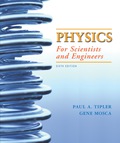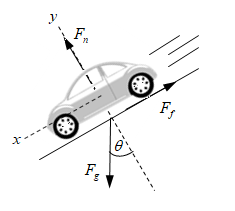
Concept explainers
(a)
The magnitude of the combined
(a)
Answer to Problem 99P
The magnitude of the combined force of friction at
Explanation of Solution
Given:
On a
Formula used:
Magnitude of force of friction at
The diagram representing the situation is given below.

Write the equation of resultant along the incline in equilibrium position.
Here,
Substitute
Rearrange above equation.
Here,
Calculation:
Whenspeed of car is
Substitute
Whenspeed of car is
Substitute
Conclusion:
Thus, the magnitude of the combined force of friction at
(b)
The power delivered by the engine to drive the car on a level road at
(b)
Answer to Problem 99P
The power delivered by the engine to drive the car on a level road at
Explanation of Solution
Given:
On a
Formula used:
Power delivered by the engine to drive the car on a level road at
Power delivered by the engine to drive the car on a level road in order to overcome friction is calculated by the expression given below.
Write the expression for power delivered.
Here,
Calculation:
Substitute
Substitute
Conclusion:
Thus, the power delivered by the engine to drive the car on a level road at
(c)
The angle of the steepest incline up which can be maintained by car at steady speed of
(c)
Answer to Problem 99P
The angle of the steepest incline up which can be maintained by car at steady speed of
Explanation of Solution
Given:
On a
Formula used:
The diagram representing the situation is given below.

Write the equation of resultant along the incline in equilibrium position.
Here,
Substitute
Rearrange above equation.
Here,
Substitute
Rearrange above equation for
Calculation:
Substitute
Conclusion:
Thus, the angle of the steepest incline up which can be maintained by car at steady speed of
(d)
The total useful work in kilometers per liter when engine goes at
(d)
Answer to Problem 99P
The total useful work in kilometers per liter when engine goes at
Explanation of Solution
Given:
The magnitude of the combined force of friction at
Formula used:
Write the expression for work done by engine.
Here,
From the condition of equivalence:
Here,
Rearrange above equation.
Calculation:
Substitute
Conclusion:
Thus, the total useful work in kilometers per liter when engine goes at
Want to see more full solutions like this?
Chapter 7 Solutions
EBK PHYSICS FOR SCIENTISTS AND ENGINEER
- In the blizzard of ’88, a rancher was forced to drop hay bales from an airplane to feed her cattle. The plane flew horizontally at 160 km/hr and dropped the bales from a height of 80 m above the flat range, (a) She wanted the bales of hay to land 30 m behind the cattle so as to not hit them. Where should she push the bales out of the airplane? (b) To not hit the cattle, what is the largest time error she could make while pushing the bales out of the airplane? Ignore air resistance.arrow_forwardA service elevator takes a load of garbage, mass 10.0 kg, from a floor of a skyscraper under construction, down to ground level, accelerating downward at a rate of 1.2m/s2 . Find the magnitude of the force the garbage exerts on the floor of the service elevator?arrow_forwardIn the very Dutch sport of ducth-dude-on-a-pole, athletes run up to a long pole and then use it to vault across a canal. At the very top of his arc, a 70kg vaulter is moving at 3.5m/s and is 5.0m from the bottom end of the pole. What vertical force does the pole exert on the vaulter (in magnitude)?arrow_forward
- A water tank is being towed on an uphill road that makes an angle of 14 deg with the horizontal with constant acceleration of 3.5 m/s^2 in the direction of motion. What would your answer be if the direction of the motion were downward on the same road with the same acceleration?arrow_forwardSuppose a rocket is at an elevation of 100 km and has an initial velocity of 1.00 x 10^4 m/s directed vertically upward. If the rocket engines do not burn and no other force other than earth's gravity acts on the rocket, how far does it go?arrow_forwardIn a forest, an explorer walks 13 km due east, then 18 km north, then he rested for an hour. After resting, the explorer continued walking 3 km north and then finally reached the hidden cabin at 72 m west. What is the total distance walked? What is the resulting displacement of the explorer from the starting point? Using the component method, find the complete resultant of the following forces: F= 2m, 40° N of E, and G = 4m at 127° counterclockwise from East?arrow_forward
- A trained sea lion slides from rest with constant acceleration down a 3.0-m-long ramp into a pool of water. If the ramp isinclined at an angle of u = 23° above the horizontal and the coefficient of kinetic friction between the sea lion and theramp is 0.26, how much time does it take for the sea lion to make a splash in the pool?arrow_forwardA motorcycle daredevil plans to ride up a 2.00 m high 26.0° ramp, sail across a 10-m-wide pool filled with hungry crocodiles, and land at ground level on the other side. He has done this stunt many times and approaches it with confidence. Unfortunately, the motorcycle engine dies just as starts up the ramp. He is going 14.9 m/s at that instant, and the rolling friction of his rubber tires is not negligible. Assuming that the local acceleration due to gravity is -9.80 m/s2, calculate the landing point (in m) relative to the 10.0 m edge of the pool. (-1.0 m means he was 1.0 m short and in the pool, +1.0 m means he landed 1.0 m past the edge). The coefficient of rolling friction for rubber on ramp is 0.02.arrow_forwardDraw each of the following vectors, then find its x- and y-components.a. d→ = (100 m, 45° below +x-axis)b. ν→ = (300 m/s, 20° above +x-axis)c. a→ = (5.0 m/s2, -y-direction)arrow_forward
- A cylindrical section of a tree trunk 50 cm in diameter and 75 cm long, is seen rolling down a road below a sawmill at a speed of 12 m/s. The road has a steady incline of 5%, meaning that if you travel 100 m along the slope of the road, you go down 5 m. Assuming that the log started at the sawmill, at least how far is the sawmill off the road?arrow_forwardA daredevil decides to jump a canyon of width 10 m. To do so, he drives a motorcycle up an incline sloped at an angle of 15°. What minimum speed must he have in order to clear the canyon?arrow_forwardLet’s say you are given an object that needs to clear two posts of equal height separated by a specific distance. Refer to for thisexample. The projectile is thrown at 25√2 m/s at an angle of 45°. If the object is to clear both posts, each with a height of 30m, find theminimum: (a) position of the launch on the ground in relation to the posts and (b) the separation between the posts. For simplicity’ssake, use a gravity constant of 10. Problems of any type in physics are much easier to solve if you list the things that you know (the“givens”).arrow_forward
 Classical Dynamics of Particles and SystemsPhysicsISBN:9780534408961Author:Stephen T. Thornton, Jerry B. MarionPublisher:Cengage Learning
Classical Dynamics of Particles and SystemsPhysicsISBN:9780534408961Author:Stephen T. Thornton, Jerry B. MarionPublisher:Cengage Learning University Physics Volume 1PhysicsISBN:9781938168277Author:William Moebs, Samuel J. Ling, Jeff SannyPublisher:OpenStax - Rice University
University Physics Volume 1PhysicsISBN:9781938168277Author:William Moebs, Samuel J. Ling, Jeff SannyPublisher:OpenStax - Rice University Glencoe Physics: Principles and Problems, Student...PhysicsISBN:9780078807213Author:Paul W. ZitzewitzPublisher:Glencoe/McGraw-Hill
Glencoe Physics: Principles and Problems, Student...PhysicsISBN:9780078807213Author:Paul W. ZitzewitzPublisher:Glencoe/McGraw-Hill Principles of Physics: A Calculus-Based TextPhysicsISBN:9781133104261Author:Raymond A. Serway, John W. JewettPublisher:Cengage Learning
Principles of Physics: A Calculus-Based TextPhysicsISBN:9781133104261Author:Raymond A. Serway, John W. JewettPublisher:Cengage Learning



